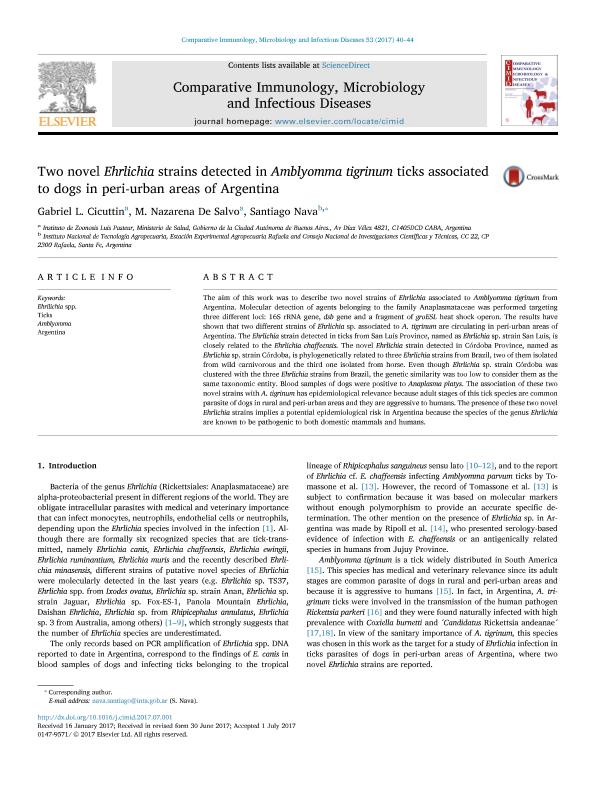Artículo
Two novel Ehrlichia strains detected in Amblyomma tigrinum ticks associated to dogs in peri-urban areas of Argentina
Fecha de publicación:
08/2017
Editorial:
Elsevier
Revista:
Comparative Immunology Microbiology And Infectious Diseases
ISSN:
0147-9571
Idioma:
Inglés
Tipo de recurso:
Artículo publicado
Resumen
Anaplasmataceae was performed targeting three different loci: 16S rRNA gene, dsb gene and a fragment of groESL heat shock operon. The results have shown that two different strains of Ehrlichia sp. associated to A. tigrinum are circulating in peri-urban areas of Argentina. The Ehrlichia strain detected in ticks from San Luis Province, named as Ehrlichia sp. strain San Luis, is closely related to the Ehrlichia chaffeensis. The novel Ehrlichia strain detected in Córdoba Province, named as Ehrlichia sp. strain Córdoba, is phylogenetically related to three Ehrlichia strains from Brazil, two of them isolated from wild carnivorous and the third one isolated from horse. Even though Ehrlichia sp. strain Córdoba was clustered with the three Ehrlichia strains from Brazil, the genetic similarity was too low to consider them as the same taxonomic entity. Blood samples of dogs were positive to Anaplasma platys. The association of these two novel strains with A. tigrinum has epidemiological relevance because adult stages of this tick species are common parasite of dogs in rural and peri-urban areas and they are aggressive to humans. The presence of these two novel Ehrlichia strains implies a potential epidemiological risk in Argentina because the species of the genus Ehrlichia are known to be pathogenic to both domestic mammals and humans.
Palabras clave:
Ehrilichia Spp.
,
Ticks
,
Amblyomma
,
Argentina
Archivos asociados
Licencia
Identificadores
Colecciones
Articulos(CCT - SANTA FE)
Articulos de CTRO.CIENTIFICO TECNOL.CONICET - SANTA FE
Articulos de CTRO.CIENTIFICO TECNOL.CONICET - SANTA FE
Citación
Two novel Ehrlichia strains detected in Amblyomma tigrinum ticks associated to dogs in peri-urban areas of Argentina; Elsevier; Comparative Immunology Microbiology And Infectious Diseases; 53; 8-2017; 40-44
Compartir
Altmétricas




